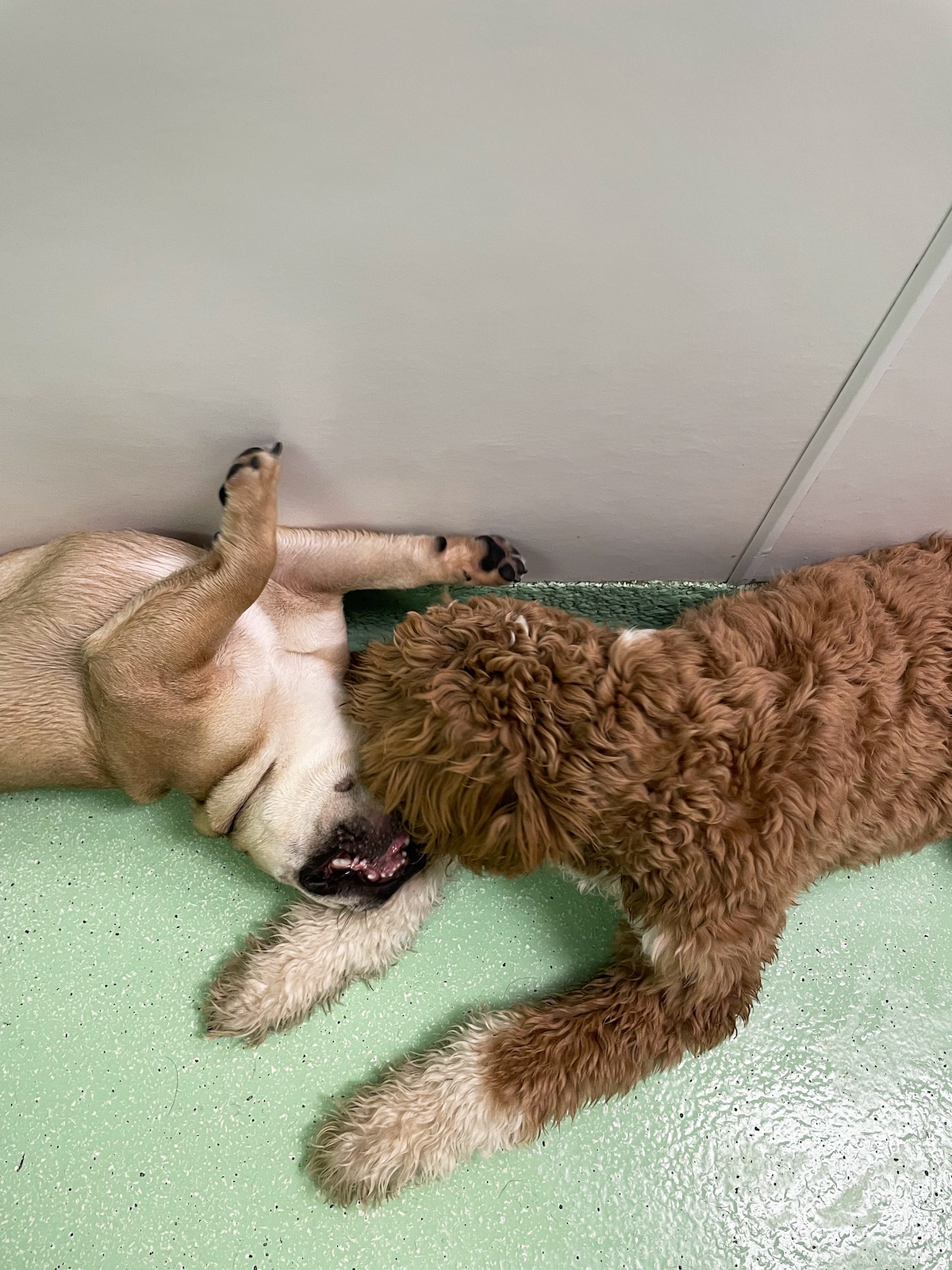Dog Germs 101
Even in the most hygienic, well-ventilated, spacious pet care facilities, the possibility of a dog acquiring Canine Cough exists. Canine Cough can be acquired from your neighbour’s dog, from a Champion show dog at a dog show, from the animal hospital where your dog just came in for treatment of a cut paw…just like the global pandemic we all navigated, if your dog develops Canine Cough shortly after that weekend stay with a professional, a friend, a visit to the dog park…take it in stride and don’t be too upset with your assumed source of origin! There may have been an infected dog that acted as a source of infection for other dogs who were contagious before showing symptoms.
Canine Cough in dogs will stimulate a coarse, dry, hacking cough about three to seven days after the dog is initially infected. It sounds as if the dog needs to “clear its throat,” and any extra activity or exercise will trigger the cough. Many dogs that acquire Canine Cough will cough every few minutes, all day long. Their general state of health and alertness will be unaffected; they usually have no rise in temperature and do not lose their appetite. The signs of Canine Cough typically last from 7 to 21 days and can be very annoying for the dog and the dog’s owners. Life-threatening cases of Canine Cough are extremely rare, and a vast m
ajority of dogs that acquire the infection will recover on their own with no medication. Cough suppressants and occasionally antibiotics are the usual treatment selections.
WHAT IS CANINE COUGH?
Actually, clinical cases of Canine Cough are usually caused by several infectious agents working together to damage and irritate the lining of the dog’s trachea and upper bronchi. The damage to the tracheal lining is pretty superficial but exposes nerve endings that become irritated simply by the passage of air over the damaged tracheal lining. The most common organisms associated with Canine Cough are the bacteria called Bordetella bronchiseptica and two viruses called Parainfluenza virus and Adenovirus, and even an organism called Mycoplasma. Once the microorganisms are eliminated, the tracheal lining will heal rapidly.
HOW IS IT TRANSMITTED?
The causative organisms can be present in the expired air of an infected dog, mu
ch the same way that human “colds” are transmitted. The airborne organisms will be carried in the air in microscopically tiny water vapour or dust particles. If inhaled by a susceptible dog, the airborne organisms can attach to the lining of the trachea and upper airway passages, find a warm, moist surface on which to reside and replicate, and eventually damage the cells they infect.
This disease seems so familiar and is commonly
called “Kennel” cough because wherever there are numbers of dogs confined together in an enclosed environment such as a kennel, animal shelter, or indoor dog show, the disease is much more likely to be spread. The same is true with the “colds” spread from human to human… they are much more likely to occur in a populated, enclosed environment such as an airplane, elevator, or office. Infected dogs can spread the organisms for days to weeks, even after seeming to have fully recovered! All it takes for contagion to occur is a single source (infected dog), an enclosed environment, and susceptible individuals close to the source of the infection.
Many dogs will have protective immunity levels to Canine Cough via minor exposures to the infective organisms and will not acquire the disease even if exposed. For other dogs that may have never been immunized, subtle exposures will be susceptible to the Bordetella bacteria and associated viruses and develop signs of coughing and hacking.
HOW IS IT TREATED?
Many dogs that contract Canine Cough will display only minor signs of coughing that may last seven to ten days and will not require any medication at all. The majority of dogs with the disease continue to eat, sleep, play and act normally… except for that annoying, dry, non-productive coughing that seems so persistent. It is always a good idea, though, to have any dog examined if coughing is noticed because some very serious respiratory diseases, such as Blastomycosis, Valley Fever, Heartworms, and even cardiac disease, might display similar-sounding coughing. Through a careful physical exam and questioning regarding the dog’s recent environment, your veterinarian will be able to establish if the dog’s respiratory signs are from Canine Cough or some other respiratory insult.
Treatment is generally limited to symptomatic relief of the coughing with non-prescription, and occasionally prescription, cough suppressants. If the dog is running a fever or there seems to be a persistent and severe cough, antibiotics are sometimes utilized to assist the dog in recovering from Canine Cough. It can happen that secondary bacterial invaders will complicate a case of Canine Cough and prolong the recovery and severely affect the upper airway. Therefore the use of antibiotics is determined on an individual basis.
HOW IS IT PREVENTED?
Many dogs, exposed to all sorts and numbers of other dogs, will never experience the effects of Canine Cough. Some dog owners, though, prefer to take advantage of the current vaccines available that are quite effective in preventing the disease. Usually, these dog owners will have to board, show, field trial, or otherwise expose their dogs to populations of other canines. Since the chances of exposure and subsequent infection rise as the dog comes in close proximity to other dogs, the decision to vaccinate or not to vaccinate varies with each individual circumstance. Generally, if your dog is not boarded or going to field trials or dog shows, you may not have a high level of need for vaccinating your dog against Canine Cough. If your dog happens to acquire Canine Cough, it will then have some immunity to subsequent exposures. The length of time these natural exposures and the vaccinations will produce protective immunity will vary greatly. How often to vaccinate seems to have a subjective and elusive answer.
Be aware that vaccinating with just the commercial Canine Cough vaccine alone (which contains only the Bordetella agent) may not be fully protective because of the other infectious agents involved in producing the disease. Other agents, such as Parainfluenza and Adenovirus, are part of the routine vaccinations generally given yearly to dogs. The intra-nasal Bordetella vaccine may produce immunity slightly faster than the injectible vaccine.
NOTE: Any vaccine takes days to weeks to stimulate the dog’s protective immunity to the disease. Vaccinating a dog the day it is exposed to disease may not offer protection. If you plan to board your dog or protect it from exposure, remember to vaccinate a few weeks before potential exposure to allow complete protective immunity to build up.

Canine Papilloma (Puppy Warts) are small, pink, round, or cauliflower-shaped warts caused by a papillomavirus. They generally occur on the lips and muzzle of a young dog (typically under two years of age) or dogs with an immune flare-up (we have seen them in sick, elderly dogs). Your dog was likely exposed long before a breakout, and an outbreak may occur when their immune system is challenged with vaccination or a virus. While gross looking, they’re generally completely painless for your dog and resolve on their own within a month. They’ll disappear as the dog’s immune system generates a response against the virus.
Dog Lice are insects that live on the skin and fur of an affected pet. Generally, clients are completely unaware of their dog having lice, and our team spots them on their wellness checks or in the salon during grooming. Infestations are uncommon in clean, healthy pets, but we do see them occasionally, usually twice a year in the spring and fall. Lice are tiny, species-specific external parasites that live on the skin and hair coat of dogs and other mammals. The lice that affect people are not the same as those that affect dogs or other animals, and the lice typically do not transfer between different species. Topical insecticides easily kill them in 2 doses from your vet. Infected dogs must be kept away from others for a few weeks while the insecticides kill the live lice and eggs to prevent further transmission. You can easily launder your pet’s bedding and be back to normal relatively soon.
Lice are spread through direct contact with a live host (another dog). So when they’re bouncing around and playing, it’s easily transmittable in group play in a professional setting like a daycare or the dog park! Keep an eye out for any irregular itching or discomfort in your best friend and regularly comb through their coat down to the skin, looking for irregularities.
Giardia (Beaver Fever) is a single-celled parasite that lives in your dog’s intestine. It can infect older dogs, but it more frequently infects puppies.
Dogs become infected when they ingest Giardia, which may be present in water or dirt. It’s really important to avoid standing water during the snow melt while out for walks that may contain feces of other animals. This and eating feces is the highest source of transmission between dogs.
So what should you watch out for in your dog? Excessive diarrhea (which can lead to dehydration), lethargy, and vomiting. A trip to the vet will be in the books for you, and they’ll likely send you home with a strong course of antibiotics and perhaps some probiotics. Giardia is treatable, but it can take a few rounds of meds to kick for some dogs. Avoid standing water at dog parks, and always pick up any dog feces you spot in public places (we call them karma poops)!
Ultimately, as we create environments for our dogs to socialize with others more than the dogs we grew up with in childhood, we will see more transmission opportunities in dense social spaces. Embracing the first few years of exposure will help your dog develop the immune system of an ox and live a long, healthy life! We appreciate you keeping us updated on your pet’s health and wellness so that we can be aware of the risks posed to our guests. We appreciate you keeping your pets home when ill to reduce the spread and transmission to other pets, especially those who may be compromised due to age or health.



